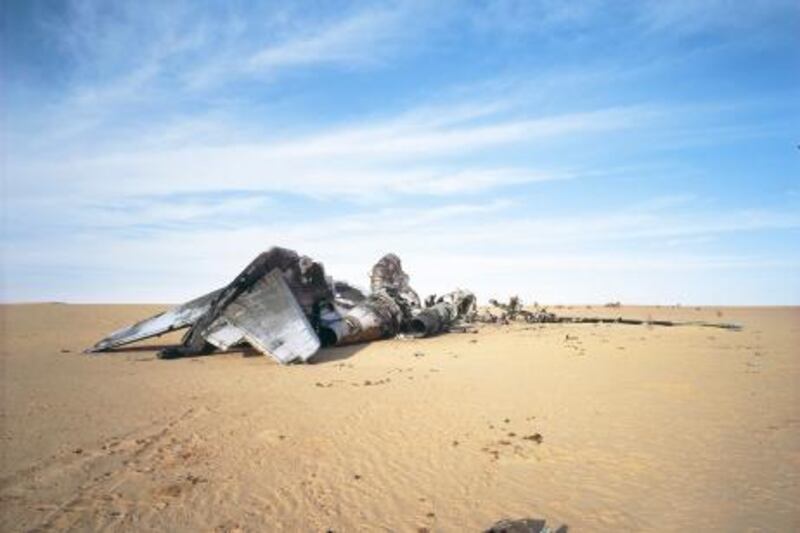Somewhere in the vastness of the Sahara, a burnt-out 727 plane is bleaching in the sun. It was once used by Colombian drug smugglers treating the desert as a back door into Europe. Without a runway, the plane simply crash-landed on the desert floor. Local people dubbed these crash-and-burn scenarios "Air Cocaine".
Myths like this are intrinsic to the Sahara today. The desert of the imagination - mile-long camel trains, windswept nomads and primordial silence - does not hold up to the desert of discontent that is reality.
Elie Domit, director of The Empty Quarter, a photography-specific gallery in DIFC, brings together three award-winning photographers, as well as an architect, a jewellery-maker and a designer-cum-alchemist for his latest show, Sahara Surreal. Visions of the Sahara both optimistic and hopeless are to be found among the works in this show.
"The idea of this show is to document myths in the Sahara now," he says. "We have stats about the phenomena these artists are examining, but here is visible proof."
The centrepiece of the ensemble is Philippe Dudouit, a two-time World Press Photo winner who has spent three years following the Tuareg rebel groups that operate in the Sahel belt from Algeria through to Mali, Niger, Libya and Chad. Working with a band of Tuareg fixers, Dudouit has managed to get into the rarely seen interior of north Africa, revealing a merciless way of life on which the deepest desert's inhabitants subsist.
"I'd heard a few rumours about these wreckages in the press," says Dudouit. "It took three days of driving before we found one.
"We had half an hour to get the shot because you have AQIM (Al Qaeda in the Islamic Maghreb), leftover rebels and the Malian army operating in the area. All these different guys chasing each other in the desert."
Another image was captured after several days of lonely driving, when the photographer and his fixers came across a mass of wandering men. These "clandestines", as they're known, have nothing and simply wander the desert in search of scarce food and scarcer opportunity. In the image, they stand with their arms outstretched, almost confrontational. "Why are you here?" they seem to demand.
"I'm just there to tell stories," says the Swiss photographer. The central story is the rebellions of nomadic Tuaregs, on-off over the past two decades, in the name of securing a piece of the region's resources for their own development. Kidnappings and mounting terrorism brought an end to the Paris-Dakar rally in the early 2000s. Similarly, the scores of tourists who would be led into the desert by the Tuareg have dwindled. It's estimated that these fears have stopped more than US$50 million (Dh184m) in income coming to the Sahel belt. As more are drawn to the black market for income, the image of the region is sullied further by recent claims that Tuareg mercenaries have been involved in Gaddafi's struggle to hold on to power.
Elsewhere in the show, the Northern Irish photographer Andrew McConnell documents refugee camps in Western Sahara, creating a subdued, intimate portrait of an underreported struggle. The Sahrawis are fighting for independence from Morocco. But McConnell's portraits have been shot at a bewitching hour of the night - lit by dim campfires and the stars. Accompanying each image is a story about its subject. Mariam Zaide Amar, for instance, is a 24-year-old woman undertaking a perilous landmine-clearance operation. Salek Labieb Basher remembers, from his youth, freeing some starving camels over the Moroccan border with his friends.
A good counterpoint to the photography is the design work included in the show. Florie Salnot has come up with a method of creating jewellery from discarded plastics and is teaching this to Sahrawis to reinvigorate their under-resourced craft industry. Markus Kayser has developed a solar-powered sinter that transforms sand into three-dimensional glass objects. And the Swedish architect Magnus Larsson presents his idea for combating desertification - creating a long, thin city of dune-like forms in the Sahara by injecting an enzyme that turns sand into cement across a controlled area.
But the hinge of Sahara Surreal is a series of photographs by Aglaïa Konrad that examines the bizarre phenomena of the desert's new towns. Like great cubes that have fallen from space, clusters of squat towers are beginning to clog the Egyptian hinterlands. They have strange names - Utopia, Golf City, New Cairo. But as Konrad's images show, they are gaudy, devoid of people and quick to decay. Their disharmony of design is only exacerbated by the contrast of concrete against sand.
One billion grains of sand are formed every second, says Larsson, while Konrad pinpoints the reality underpinning this show: deserts - and the people who live in them - refuse to be tamed.
Sahara Surreal is at The Empty Quarter Gallery, Gate Village, DIFC, Dubai, until October 14. www.theemptyquarter.com.





